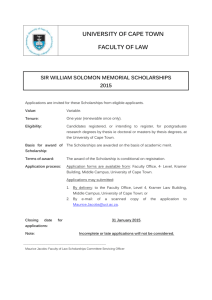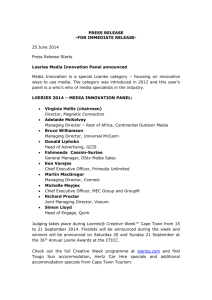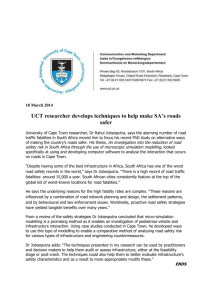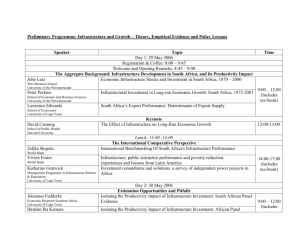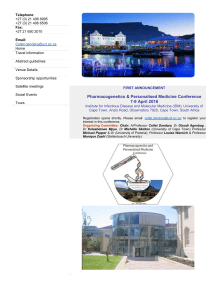How will climate change affect South Africa
advertisement
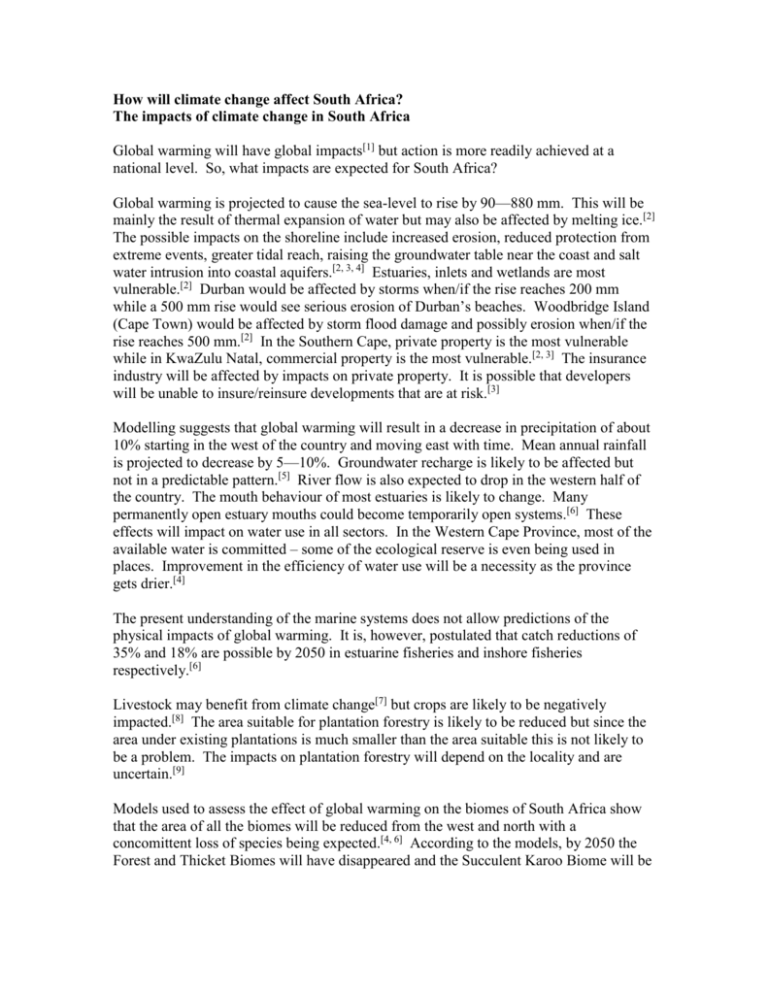
How will climate change affect South Africa? The impacts of climate change in South Africa Global warming will have global impacts[1] but action is more readily achieved at a national level. So, what impacts are expected for South Africa? Global warming is projected to cause the sea-level to rise by 90—880 mm. This will be mainly the result of thermal expansion of water but may also be affected by melting ice.[2] The possible impacts on the shoreline include increased erosion, reduced protection from extreme events, greater tidal reach, raising the groundwater table near the coast and salt water intrusion into coastal aquifers.[2, 3, 4] Estuaries, inlets and wetlands are most vulnerable.[2] Durban would be affected by storms when/if the rise reaches 200 mm while a 500 mm rise would see serious erosion of Durban’s beaches. Woodbridge Island (Cape Town) would be affected by storm flood damage and possibly erosion when/if the rise reaches 500 mm.[2] In the Southern Cape, private property is the most vulnerable while in KwaZulu Natal, commercial property is the most vulnerable.[2, 3] The insurance industry will be affected by impacts on private property. It is possible that developers will be unable to insure/reinsure developments that are at risk.[3] Modelling suggests that global warming will result in a decrease in precipitation of about 10% starting in the west of the country and moving east with time. Mean annual rainfall is projected to decrease by 5—10%. Groundwater recharge is likely to be affected but not in a predictable pattern.[5] River flow is also expected to drop in the western half of the country. The mouth behaviour of most estuaries is likely to change. Many permanently open estuary mouths could become temporarily open systems.[6] These effects will impact on water use in all sectors. In the Western Cape Province, most of the available water is committed – some of the ecological reserve is even being used in places. Improvement in the efficiency of water use will be a necessity as the province gets drier.[4] The present understanding of the marine systems does not allow predictions of the physical impacts of global warming. It is, however, postulated that catch reductions of 35% and 18% are possible by 2050 in estuarine fisheries and inshore fisheries respectively.[6] Livestock may benefit from climate change[7] but crops are likely to be negatively impacted.[8] The area suitable for plantation forestry is likely to be reduced but since the area under existing plantations is much smaller than the area suitable this is not likely to be a problem. The impacts on plantation forestry will depend on the locality and are uncertain.[9] Models used to assess the effect of global warming on the biomes of South Africa show that the area of all the biomes will be reduced from the west and north with a concomittent loss of species being expected.[4, 6] According to the models, by 2050 the Forest and Thicket Biomes will have disappeared and the Succulent Karoo Biome will be nearly gone. It is expected that the ‘emptied’ areas will have species poor, arid adapted vegetation.[6] At a species level, global warming is expected to result in the following effects if no action is taken. Species will go extinct. Surviving species may be expected to experience alterations in their ranges in the form of expansions, reductions and shifts. A few species may remain relatively unaffected by global warming.[10, 11] Among the species projected to experience range expansions are the Plasmodium species responsible for malaria and the Schistosoma species responsible for Bilharzia (= Schistosomiasis).[5, 12, 13] Malaria impacts take the form of work days lost due to illness and premature death.[12] Bilhazia has a low mortality rate but significantly reduces productivity[14] – the truth of this statement I can personally attest. DDT is once again being used to control the vectors of malaria[13] so further health impacts may be expected. Impacts from malaria are already expected to be great in 2010.[12] The projected changes in biodiversity are hugely important for conservation planning.[10, 11] In the Western Cape, the planned megareserves had very little impact on the status of species of the Proteaceae after climate change. Only one species benefited slightly from the megareserves.[6] The Kruger National Park may lose as much as 66% of its animal species and with them, much of its value for tourism.[6, 11] Erasmus et al.[11] suggest that indicator species be identified for climate change. Williams et al.[15] suggest identifying and protecting corridors for dispersal. Habitat fragmentation is a complicating factor in conservation planning for climate change.[16] The potential loss of tourism is the main impact likely to be felt in the market economy. It is estimated that as much as 3% of GDP could be lost as a result of the global warming – particularly through impacts on tourism. A number of major impacts (e.g. health and subsistence forest utilization) are categorized as non-market impacts as the national accounts do not show them directly.[6, 17] The effects of the impacts of global warming may be summarized as follows: resource rich groups are not vulnerable but resource poor groups are vulnerable.[5] Most of the studies looking at the effects of global warming do not consider mitigation[3, 10, 11, 17] but some action will be taken.[17] Kiker[5] suggests that actions to adapt to climate change need to be coordinated to minimise the cost and ensure that uncoordinated action does not increase the vulnerability of the region. Turpie et al.[17] note that mitigation and/or adaptation would be very difficult and/or costly for some of the impacts. In some instances mitigation may be impossible, e.g. it is impossible to mitigate impacts on existence values.[17] The projected impacts of global warming will be exacerbated by humanity in 2 ways: population growth[10, 11] and environmental refugees.[18] The population growth rate in South Africa was 2.2% in 1999.[13] The healthy economy[13] makes South Africa an attractive destination for displaced people. In my opinion, coordinated reactions from government are unlikely because (1) projected impacts are in the future (even 2010) and many of the projections are for 2050 or 2100 – by which time the present politicians will be ancient (2050) or dead (2100) and (2) the predictions all involve uncertainty - as the Bush Administration has demonstrated, uncertainty can be used to avoid taking action.[19] To conclude, South Africa will be heavily impacted by global warming but plans are being made to reduce the impacts on biodiversity. Hopefully, such plans will be successfully implemented. References 1. IPCC. 2007. Summary for Policymakers. In: Solomon S, Qin D, Manning M, Chen Z, Marquis M, Avery KB, Tignor M, Miller HL, editors. Climate Change 2007: The Physical Science Basis. Contribution of Working Group I to the Fourth Assessment Report of the Intergovernmental Panel on Climate Change. Cambridge, United Kingdom and New York, NY, USA: Cambridge University Press. Available from: http://planet.uwc.ac.za/nisl/climate_change/course_documents/AR4WG1_Pub_SPM.pdf. 2. Winkler H. 2002. Property damage from sea-level rise. In: Turpie, J, Winkler H, Spalding-Fecher R, Midgley G, editors. Economic Impacts of Climate Change in South Africa: a Preliminary Analysis of Unmitigated Damage Costs. Cape Town: Southern Waters Ecological Research & Consulting & Energy & Development Research Centre, University of Cape Town. pp. 42—45. Available from: http://www.fitzpatrick.uct.ac.za/pdf/turpie02.pdf 3. Hughes P, Brundrit GB. 1992. An index to assess South Africa’s vulnerability to sealevel rise. South African Journal of Science 88 (6): 308—311. 4. Midgley GF, Chapman RA, Hewitson B, De Wit M, Ziervogel G, Mukheibir P, Van Niekerk L, Tadross M, Van Wilgen BW, Kgope B, Morant PD, Scholes RJ, Forsyth GG. 2005. A Status Quo, Vulnerability and Adaptation Assessment of the Physical and SocioEconomic Effects of Climate Change in the Western Cape. Technical report, CSIR Report No. ENV-S-C 2005-073. Cape Town: Department of Environmental Affairs and Development Planning, Provincial Government of the Western Cape. 171p. Available from: http://www.capegateway.gov.za/other/2006/9/wcape_climate_change_impacts_sep06.pdf . 5. Kiker GA. 2000. South African Country Study on Climate Change: Synthesis Report for the Vulnerability and Adaptation section. Pretoria: South African Department of Environmental Affairs and Tourism. Available from: http://www.sanbi.org/countrystudy/Final%20Synthesis%20Report.PDF 6. Turpie J. 2002. Change in ecosystem function and loss of biodiversity. In: Turpie, J, Winkler H, Spalding-Fecher R, Midgley G, editors. Economic Impacts of Climate Change in South Africa: a Preliminary Analysis of Unmitigated Damage Costs. Cape Town: Southern Waters Ecological Research & Consulting & Energy & Development Research Centre, University of Cape Town. pp. 6—28. Available from: http://www.fitzpatrick.uct.ac.za/pdf/turpie02.pdf 7. Winkler H. 2002. Rangelands. In: Turpie, J, Winkler H, Spalding-Fecher R, Midgley G, editors. Economic Impacts of Climate Change in South Africa: a Preliminary Analysis of Unmitigated Damage Costs. Cape Town: Southern Waters Ecological Research & Consulting & Energy & Development Research Centre, University of Cape Town. pp. 29—30. Available from: http://www.fitzpatrick.uct.ac.za/pdf/turpie02.pdf 8. Winkler H. 2002. Agricultural crops. In: Turpie, J, Winkler H, Spalding-Fecher R, Midgley G, editors. Economic Impacts of Climate Change in South Africa: a Preliminary Analysis of Unmitigated Damage Costs. Cape Town: Southern Waters Ecological Research & Consulting & Energy & Development Research Centre, University of Cape Town. pp. 31—38. Available from: http://www.fitzpatrick.uct.ac.za/pdf/turpie02.pdf 9. Turpie J. 2002. Plantation forestry. In: Turpie, J, Winkler H, Spalding-Fecher R, Midgley G, editors. Economic Impacts of Climate Change in South Africa: a Preliminary Analysis of Unmitigated Damage Costs. Cape Town: Southern Waters Ecological Research & Consulting & Energy & Development Research Centre, University of Cape Town. pp. 39—41. Available from: http://www.fitzpatrick.uct.ac.za/pdf/turpie02.pdf 10. Bomhard B, Richardson DM, Donaldson JS, Hughes GO, Midgley GF, Raimondo DC, Rebelo AG, Rouget M, Thuiller W. 2005. Potential impacts of future land use and climate change on the Red List status of the Proteaceae in the Cape Floristic Region, South Africa. Global Change Biology 11 (9): 1452—1468. Available from: http://www.blackwell-synergy.com/doi/abs/10.1111/j.1365-2486.2005.00997.x 11. Erasmus BF; Van Jaarsveld AS; Chown SL; Kshatriya M, Wessels KJ. 2002. Vulnerability of South African Animal taxa to Climate Change. Global Change Biology 8: 679—693. Available from: http://www.blackwellsynergy.com/doi/abs/10.1046/j.1365-2486.2002.00502.x 12. Spalding-Fecher R. 2002. Health impacts – Malaria. In: Turpie, J, Winkler H, Spalding-Fecher R, Midgley G, editors. Economic Impacts of Climate Change in South Africa: a Preliminary Analysis of Unmitigated Damage Costs. Cape Town: Southern Waters Ecological Research & Consulting & Energy & Development Research Centre, University of Cape Town. pp. 46—53. Available from: http://www.fitzpatrick.uct.ac.za/pdf/turpie02.pdf 13. Government of South Africa. 2000. South Africa: Initial National Communication under the United Nations Framework Convention on Climate Change. Pretoria: South African National Government. 118 p. Available from: http://unfccc.int/resource/docs/natc/zafnc01.pdf 14. Wikipedia contributors. Schistosomiasis [Internet]. Wikipedia, The Free Encyclopedia; 2007 Jul 10, 19:38 UTC [cited 2007 Jul 11]. Available from: http://en.wikipedia.org/w/index.php?title=Schistosomiasis&oldid=143796407. 15. Williams P, Hannah L, Andelman S, Midgley G, Araujo M, Hughes G, Manne L, Martinez-Meyer E, Pearson R. 2005. Planning for Climate Change: Identifying Minimum-Dispersal Corridors for the Cape Proteaceae. Conservation Biology 19 (4): 1063—1074. Available from: http://www.blackwellsynergy.com/doi/abs/10.1111/j.1523-1739.2005.00080.x. 16. Halpin P. 1997. Global Climate Change and Natural-Area Protection: Management Responses and Research Directions. Ecological Applications 7 (3): 828—843. Available from: http://nisl.uwc.ac.za/courses/361780/docs/Halpin_EcoApp_1997_Management_response. pdf. 17. Turpie J, Winkler H, Spalding-Fecher R, Midgley G, editors. 2002. Economic Impacts of Climate Change in South Africa: a Preliminary Analysis of Unmitigated Damage Costs. Cape Town: Southern Waters Ecological Research & Consulting & Energy & Development Research Centre, University of Cape Town. 58 p. Available from: http://www.fitzpatrick.uct.ac.za/pdf/turpie02.pdf 18. Simms A, Conisbee M. 2003. Environmental Refugees: the Case for Recognition. London: NEF. 47p. Available from: http://www.neweconomics.org/gen/uploads/lpce0g55xjx5eq55mfjxbb5523102003180040 .pdf. 19. Knight R. 2007. Global Warming, Warning or Waring: Bush vs Blair issue [Internet]. Eco- and Geo-informatics blog, Biodiversity and Conservation Biology Department, University of the Western Cape; Updated 2007 May 10 [cited 2007 Ju1. 11]. Available from: http://connected.uwc.ac.za/blog/index.php?/article/global-warmingwarning-or-waring-bush-vs-blair-issue/.



